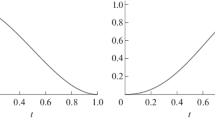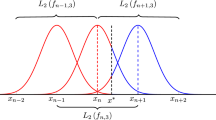Abstract
This paper is a continuation of a series of papers devoted to the construction and investigation of the properties of integro-differential polynomial splines of the fifth order. It is supposed that values of function in grid nodes and values of integrals over intervals are known. Solving the system of linear algebraic equations, we find basic splines. An approximation of the function in this paper is constructed on every grid interval separately using values of the function in two adjacent grid nodes and the values of three integrals over intervals, and basic splines.
We call this approximation an integro-differential spline and we call these basic splines integro-differential basic splines. The properties of interpolation with integro-differential polynomial basic splines are investigated. A comparison of the properties of integro-differential approximations for a different choice of integrals is presented. A comparison of the integro-differential approximation with approximation using polynomial splines of the Lagrangian type is made. Numerical examples are presented.
Access provided by Autonomous University of Puebla. Download conference paper PDF
Similar content being viewed by others
Keywords
1 Introduction
A variety of splines with different properties are used in calculations in many engineering projects [1, 3]. Among them are analysis-suitable T-splines of arbitrary degree, which are useful for modeling cracks in plane problems, and for the solution of boundary-value problems, cubic, bicubic and biquadratic B-splines, trigonometric, orthogonal splines. These splines are applied to the construction of curves and surfaces, to the designing of ship hulls, to the transformation of a sound signal’s frequency and to many others [1,2,3,4,5,6,7,8,9,10,11,12,13].
This paper is a continuation of the series of papers devoted to the construction and investigation of the properties of integro-differential polynomial splines of the fifth order [7, 14, 15]. In this paper we discuss the construction of polynomial splines which use three integrals over subintervals in addition to the values of the function in the nodes. As in previous papers, we construct the approximation separately for each subinterval. As usual, local spline approximation uses values of the approximated function and, sometimes, values of its derivatives.
2 Approximation of the Function
Suppose that n, m are natural numbers, while a, b, c, d, h are real numbers, h = (b-a)/n. Let the function \( u\left( x \right) \) be such that \( u \in C^{5} \left[ {a - 3h,b} \right]. \) We have the grid of interpolation nodes \( x_{i} \) such that \( x_{ - k} = a - kh,k = 3,2,1 \), \( x_{0} = a,x_{i + 1} = x_{i} + h,i = 0, \ldots ,n,x_{n} = b \).
Suppose that \( u\left( {x_{i} } \right),i = 0,1, \ldots ,n \) and \( \int_{{x_{i - 1} }}^{{x_{i} }} {u\left( \xi \right)d\xi } , \int_{{x_{i - 2} }}^{{x_{i} }} {u\left( \xi \right)d\xi } ,\int_{{x_{i - 3} }}^{{x_{i} }} {u\left( \xi \right)d\xi , i = 0, \ldots ,n} \) are known. We denote \( \tilde{\tilde{u}}\left( x \right) \) as an approximation of function u(x) in interval \( \left[ {x_{i} ,x_{i + 1} } \right] \subset \left[ {a,b} \right] \):
We obtain basic splines \( w_{i} \left( x \right), \) \( w_{i + 1} \left( x \right), \) \( w_{i}^{ < - 1,0 > } (x),w_{i}^{ < - 2,0 > } \left( x \right),w_{i}^{ < - 3,0 > } \left( x \right) \) from system: \( \tilde{\tilde{u}}(x) \equiv u(x),\quad u(x) = x^{i - 1} ,\quad i = 1,2,3,4,5. \)
If \( x = x_{i} + th,\quad t \in [0,1], \) then the basic splines can be written in the form:
We can also construct the approximation in this form:
We obtain basic splines \( \omega_{i,0} \left( x \right),\;\;\omega_{i + 1,0} \left( x \right), \)\( \omega_{i}^{ < s,s + 1 > } \left( x \right),s = - 1, - 2, - 3 \), from the system:
If \( x = x_{i} + th,\quad t \in \left[ {0,1} \right] \), then the basic splines can be written in the following form:
Our aim is to determine if \( V(x) = \tilde{\tilde{u}} \left( x \right). \)
Lemma 1.
Let function \( u \in C^{5} [a - 3h,b] \). The next statement is valid:
Proof.
It can be shown that the next relations are valid:
Therefore, we obtain:
The proof is complete.
Lemma 2.
Let the function be such that \( u \in C^{5} [a - 3h,b] \). The next statements are valid:
Proof.
Firstly, let us notice that statements (1)–(2) follow from the next relations:
Similarly, statements (3)–(5) follow from the next relations:
The proof is complete.
Now we can find the points \( \zeta_{1} , \zeta_{2} , \zeta_{3} \) such that
We can construct approximation \( \tilde{u}(x) \), \( x \in [x_{j} ,x_{j + 1} ] \), in the form:
The interpolation of the Lagrange type with nodes \( \zeta_{1} , \zeta_{2} , \zeta_{3} \), \( \zeta_{4} = x_{j} \), \( \zeta_{5} = x_{j + 1} , \) has the form
where \( W\left( x \right) = \left( {x - \zeta_{1} } \right)\left( {x - \zeta_{2} } \right)\left( {x - \zeta_{3} } \right)\left( {x - \zeta_{4} } \right)\left( {x - \zeta_{5} } \right). \)
The remainder term of the Lagrange interpolation (3) is as follows:
Table 1 shows actual errors of approximation of functions constructed with formula (1) and theoretical errors of approximation of functions constructed with formula (3) when \( \left[ {a,b} \right] = \left[ { - 1,1} \right],h = 0.1. \) Calculations were done in Maple with Digits = 15.
3 Comparison with Lagrange Type Splines
Suppose we know the values of function \( u \in C^{5} [a - 3h,b] \) in the points x i . We consider the interpolation with Lagrange type splines
It can be found that \( \omega_{j + 1} \left( x \right) = \left( {x - x_{j} } \right)\left( {x - x_{j - 1} } \right)\left( {x - x_{j - 2} } \right)\left( {x - x_{j - 3} } \right)/Z_{j + 1} \),
Lemma 3.
Suppose \( u \in C^{5} [a - 3h,b] \). There is a point \( \eta \in [x_{j - 3} ,x_{j + 1} ] \), such that
Proof.
The points \( x_{j - i} , \, i \, = - 1,0,1,2,3 \) are the points of interpolation. Using the formula of the remainder term of Lagrange interpolation we obtain the formula.
Corollary.
If \( M = \mathop {max}\limits_{{x \in \left[ {a - 3h,b} \right]}} \, \left| {u^{\left( 5 \right)} \left( x \right)} \right| \) and we put \( x = x_{j} + th,\quad t \in \left[ {0,1} \right] \), then
Proof.
Obviously,
It can be obtained, that
\( max_{{t \in \left[ {0,1} \right]}} \left| {t\left( {t - 1} \right)\left( {t + 1} \right)\left( {t + 2} \right)\left( {t + 3} \right)} \right| = 3.63 \),
when \( t \approx 0.6444 \).
The proof is complete.
Table 2 shows actual and theoretical errors of approximation of functions constructed with formula (4) when \( \left[ {a,b} \right] = \left[ { - 1,1} \right],\quad h = 0.1. \) Calculations were done in Maple with Digits = 15.
4 Conclusion
Here we investigated approximation using the values of integrals of the function over the subintervals immediately to the left of this subinterval. If the values of the integral of the function are unknown, we will use quadrature formulae with the fifth order of approximation.
References
Casquero, H., Liu, L., Zhang, Y., Reali, A., Gomez, H.: Isogeometric collocation using analysis-suitable T-splines of arbitrary degree. Comput. Methods Appl. Mech. Eng. 301, 164–186 (2016)
Doganalp, S., Selvi, H.Z.: Local geoid determination in strip area projects by using polynomials, least-squares collocation and radial basis functions. Meas. J. Int. Meas. Confederation 73, 429–438 (2015)
Habib, S.H., Belaidi, I.: Extended isogeometric analysis using analysis-suitable T-splines for plane crack problems. Mechanika 23(1), 11–17 (2017)
Jahangiry, H.A., Tavakkoli, S.M.: An isogeometrical approach to structural level set topology optimization. Comput. Methods Appl. Mech. Eng. 319, 240–257 (2017)
Abbas, M., Majid, A.A., Awang, M.N.H., Ali, J.: Shape-preserving rational bi-cubic spline for monotone surface data. WSEAS Trans. Math. 11(7), 644–657 (2012)
Abdul Karim, S.A., Mohd Rosli, M.A., Mohd Mustafa, M.I.: Cubic spline interpolation for petroleum engineering data. Appl. Math. Sci. 8(102), 5083–5098 (2014)
Burova, I.: On integro-differential splines construction, advances in applied and pure mathematics. In: Proceedings of the 7th International Conference on Finite Differences, Finite Elements, Finite Volumes, Boundary Elements (F-and-B 2014), Gdansk, Poland, 15–17 May, pp. 57–61 (2014)
Saini, S., Mishra, H.K.: A new quartic B-spline method for third-order self-adjoint singularly perturbed boundary value problems. Appl. Math. Sci. 9(8), 399–408 (2015)
Sarfraz, M.: Generating outlines of generic shapes by mining feature points. WSEAS Trans. Syst. 13, 584–595 (2014)
Sarfraz, M., Al-Dabbous, N.: Curve representation for outlines of planar images using multilevel coordinate search. WSEAS Trans. Comput. 12(2), 62–73 (2013)
Skala, V.: Fast interpolation and approximation of scattered multidimensional and dynamic data using radial basis functions. WSEAS Trans. Math. 12(5), 501–511 (2013)
Zamani, M.: A new, robust and applied model for approximation of huge data. WSEAS Trans. Math. 12(6), 727–735 (2013)
Zhuang, X., Mastorakis, N.E.: A model of virtual carrier immigration in digital images for region segmentation. WSEAS Trans. Comput. 14, 708–718 (2015)
Burova, I.G., Doronina, A.G.: On approximations by polynomial and nonpolynomial integro-differential splines. Appl. Math. Sci. 10(13–16), 735–745 (2016)
Burova, I.G., Poluyanov, S.V.: On approximations by polynomial and trigonometrical integro- differential splines. Int. J. Math. Models Methods Appl. Sci. 10, 190–199 (2016)
Author information
Authors and Affiliations
Corresponding author
Editor information
Editors and Affiliations
Rights and permissions
Copyright information
© 2019 Springer International Publishing AG, part of Springer Nature
About this paper
Cite this paper
Burova, I.G., Doronina, A.G. (2019). Errors of Approximation with Polynomial Splines of the Fifth Order. In: Ntalianis, K., Croitoru, A. (eds) Applied Physics, System Science and Computers II. APSAC 2017. Lecture Notes in Electrical Engineering, vol 489. Springer, Cham. https://doi.org/10.1007/978-3-319-75605-9_6
Download citation
DOI: https://doi.org/10.1007/978-3-319-75605-9_6
Published:
Publisher Name: Springer, Cham
Print ISBN: 978-3-319-75604-2
Online ISBN: 978-3-319-75605-9
eBook Packages: EngineeringEngineering (R0)




